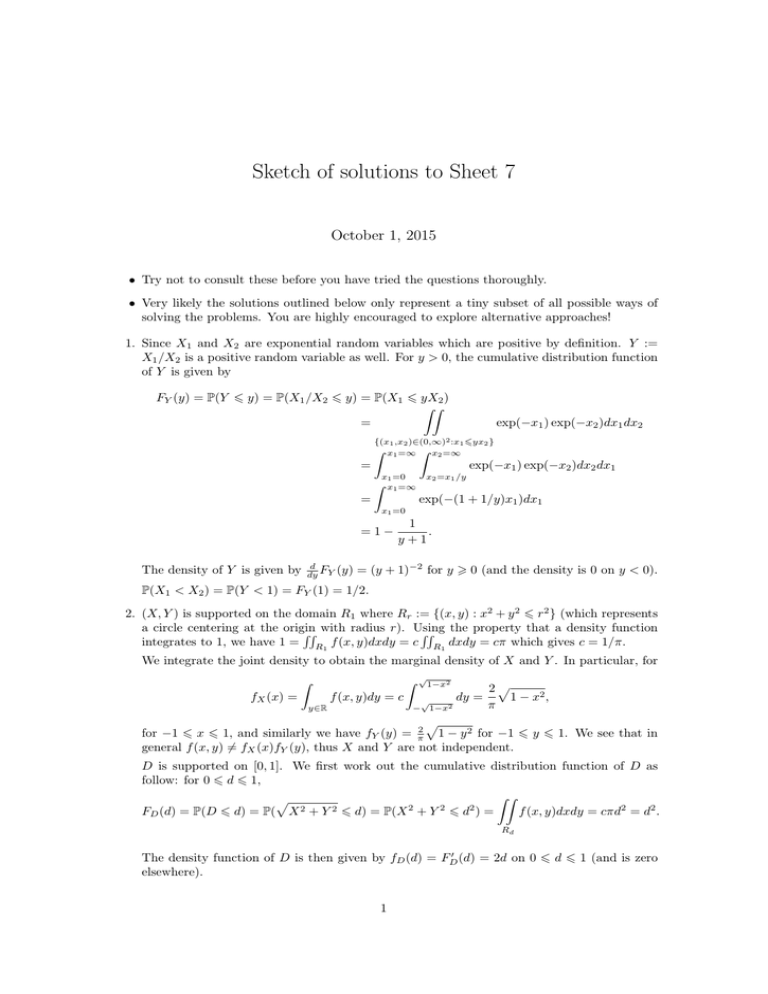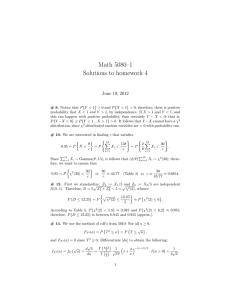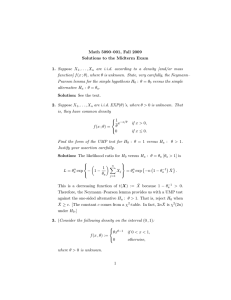Sketch of solutions to Sheet 7 October 1, 2015
advertisement

Sketch of solutions to Sheet 7
October 1, 2015
• Try not to consult these before you have tried the questions thoroughly.
• Very likely the solutions outlined below only represent a tiny subset of all possible ways of
solving the problems. You are highly encouraged to explore alternative approaches!
1. Since X1 and X2 are exponential random variables which are positive by definition. Y :=
X1 /X2 is a positive random variable as well. For y > 0, the cumulative distribution function
of Y is given by
FY (y) = P(Y 6 y) = P(X1 /X2 6 y) = P(X1 6 yX2 )
ZZ
=
exp(−x1 ) exp(−x2 )dx1 dx2
)∈(0,∞)2 :x
{(x1 ,x2
Z x1 =∞
Z
1 6yx2 }
x2 =∞
=
exp(−x1 ) exp(−x2 )dx2 dx1
x1 =0
Z x1 =∞
=
x2 =x1 /y
exp(−(1 + 1/y)x1 )dx1
x1 =0
=1−
The density of Y is given by
d
dy FY
1
.
y+1
(y) = (y + 1)−2 for y > 0 (and the density is 0 on y < 0).
P(X1 < X2 ) = P(Y < 1) = FY (1) = 1/2.
2. (X, Y ) is supported on the domain R1 where Rr := {(x, y) : x2 + y 2 6 r2 } (which represents
a circle centering at the origin
RR with radius r). Using
RR the property that a density function
integrates to 1, we have 1 = R1 f (x, y)dxdy = c R1 dxdy = cπ which gives c = 1/π.
We integrate the joint density to obtain the marginal density of X and Y . In particular, for
Z
fX (x) =
Z
f (x, y)dy = c
y∈R
√
1−x2
√
− 1−x2
dy =
2p
1 − x2 ,
π
p
for −1 6 x 6 1, and similarly we have fY (y) = π2 1 − y 2 for −1 6 y 6 1. We see that in
general f (x, y) 6= fX (x)fY (y), thus X and Y are not independent.
D is supported on [0, 1]. We first work out the cumulative distribution function of D as
follow: for 0 6 d 6 1,
ZZ
p
f (x, y)dxdy = cπd2 = d2 .
FD (d) = P(D 6 d) = P( X 2 + Y 2 6 d) = P(X 2 + Y 2 6 d2 ) =
Rd
0
The density function of D is then given by fD (d) = FD
(d) = 2d on 0 6 d 6 1 (and is zero
elsewhere).
1
3. P(N is even) = P(N ∈ {0, 2, 4, ...}) =
e−λ λ2k
k=0 (2k)!
P∞
Recall that
eλ = 1 +
and
e−λ = 1 −
= e−λ 1 +
λ2
2!
+
λ4
4!
+ ··· .
λ
λ2
λ3
+
+
+ ···
1!
2!
3!
λ
λ2
λ3
+
−
+ ··· .
1!
2!
3!
Hence
λ2
1 λ
λ4
e + e−λ = 1 +
+
+ ···
2
2!
4!
−λ
and thus P(N is even) = e 2 eλ + e−λ .
On the other hand, P(N = n, N is even) =
odd. Therefore
P(N = n|N is even) =
=
E(N |N is even) =
∞
X
e−λ λn
n!
if n is even, or otherwise is 0 when n is
P(N = n, N is even)
P(N is even)
(
2λn
, n = 0, 2, 4, ...
(eλ +e−λ )n!
0,
n = 1, 3, 5, ...
nP(N = n|N is even)
n=0
=
∞
X
2
λ2n
(2n)
λ
−λ
e + e n=0
(2n)!
∞
X
2λ
λ2n−1
= λ
e + e−λ n=1 (2n − 1)!
λ3
λ5
2λ
λ
+
+
+
·
·
·
= λ
e + e−λ 1!
3!
5!
λ
= λ
eλ − e−λ
e + e−λ
= λ tanh(λ).
P∞ λ2k
P∞ λ2k−1
P∞
+ C1θ k=1 (2k−1)!
= 2Cθ θ (eλ + e−λ ) + 2C1 θ (eλ − e−λ ),
4. 1 = k=0 P(Z = k) = Cθθ k=0 (2k)!
2
which gives Cθ = 12 (θ + 1)eλ + (θ − 1)e−λ . Check that Cθ → ∞ and Cθθ → eλ +e
−λ as
θ → ∞. Hence we have
(
2
λz
z = 0, 2, 4, · · · ;
λ +e−λ z! ,
e
Pθ (Z = z) →
0,
z = 1, 3, 5, · · ·
as θ → ∞. This expression is equivalent to the one computed in question 3.
5. (a) The two events “X = 0” and “Y 6= 0” are mutually exclusive and cannot happen at
the same time, thus P(X = 0, Y 6= 0) = 0. On the other hand, P(X = 0) = 1/3,
P(Y 6= 0) = P(X = 1) + P(X = −1) = 2/3. In particular, P(X = 0)P(Y 6= 0) = 2/9 6=
0 = P(X = 0, Y 6= 0). Thus X and Y are not independent.
(b) The joint probability mass function pXY (x, y) and marginal probability mass function
pX (x) and pY (y) can be represented below:
X and Y are not independent since one can check that pXY (x, y) 6= pX (x)pY (y) (for
example, pXY (−1, 1) = 1/3 but pX (−1)pY (1) = (1/3)(2/3) = 2/9 6= pXY (−1, 1).)
2
1
0
y
pX (x)
x
0
0
1/3
1/3
-1
1/3
0
1/3
pY (y)
1
1/3
0
1/3
2/3
1/3
P
(c) From the joint pmf, we can work out E(XY ) = x,y xyP(X = x, Y = y) = (1)(−1)(1/3)+
(0)(0)(1/3) + (1)(1)(1/3) = 0. From the marginal pmf’s of X and Y it is also easy to
check E(X) = 0 and E(Y ) = 2/3. Hence E(XY ) = 0 = E(X)E(Y ). Here the covariance/correlation between X and Y is zero, although they are not independent.
6. For X ∼ Bin(n, p), its pgf is
GX (t) = E(tX ) =
n
X
tk Ckn pk (1 − p)n−k =
k=0
n
X
Ckn (pt)k (1 − p)n−k = (pt + 1 − p)n .
k=0
For Y ∼ Bin(m, p) which is independent of X, the pgf of X + Y is given by GX (t)GY (t) =
(pt + 1 − p)n (pt + 1 − p)m = (pt + 1 − p)n+m , which is identical to the pgf of Bin(n + m, p).
Hence X + Y ∼ Bin(n + m, p) by the unique correspondence between distribution and pgf.
g
(k)
(0)
(k)
7. With a given pgf gX (·), P(X = k) = Xk! . In the case of gX (t) = eθ(t−1) we have gX (t) =
k −θ
e
θk eθ(t−1) . Hence P(X = k) = θ k!
(for k = 0, 1, 2, ...), i.e. X has a Poisson(θ) distribution.
R∞
R∞
8. For X ∼ exp(λ), its mgf is given by mX (t) = E(etX ) = 0 etu λe−λu du = λ 0 e−(λ−t)u du =
λ
λ−t . (Need λ > t for the mgf to be well-defined, otherwise the indefinite integral diverges.)
λ
2λ
00
We can obtain m0X (t) = (λ−t)
Hence E(X) = m0X (0) = 1/λ and
2 and mX (t) = (λ−t)3 .
E(X 2 ) = m00X (0) = 2/λ2 . Then var(X) = E(X 2 ) − (E(X))2 = 1/λ2 .
9. We first obtain the density function f by differentiating the CDF:
f (x) =
d
(1 − (1 + λx)e−λx ) = λ2 xe−λx
dx
for x > 0. Then the mgf is computed via
Z ∞
m(t) = E(etX ) =
etx λ2 xe−λx dx
0
Z ∞
= λ2
xe−(λ−t)x dx
0
λ2
λ2
=
xe−(λ−t)x |0∞ +
λ−t
λ−t
λ2
e−(λ−t)x |0∞
=0+
(λ − t)2
2
λ
=
.
λ−t
Z
∞
e−(λ−t)x dx
0
E(X) can be computed via m0 (0). Here m0 (t) = 2λ2 (λ−t)−3 and hence E(X) = m0 (0) = 2/λ.
3





